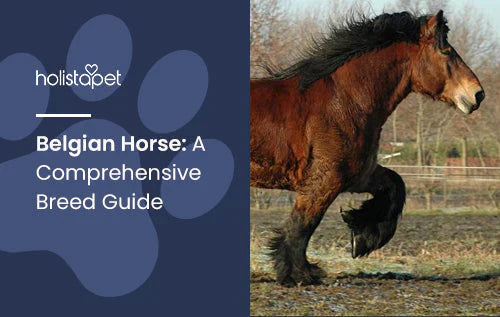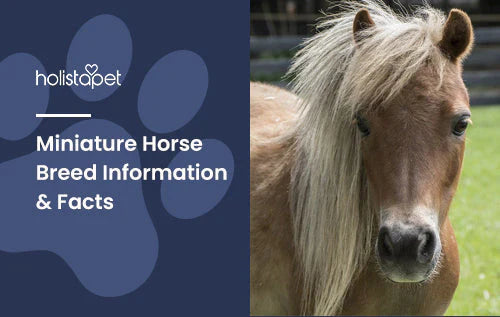The Belgian is a strong and powerful horse breed that has been used for both farm work and agricultural work since the Middle Ages. Its impressive ability to pull large objects makes it one of the most talented draft breeds in the world. Today, the Belgian horse’s strength and gentle nature make it a popular choice for heavy lifting.
The American Association of Importers and Breeders of Belgian Draft Horses was established in 1887 and played a significant role in promoting Belgian horses in the United States, especially following events that increased public interest in the breed. The Belgian draft horse is one of the most beautiful, durable animals to come out of Europe. If you want to own a Belgian horse of your own, you’re in luck! We’ve gathered all the necessary information you need to know about this kindhearted breed, so let’s get to know the Belgian horse!
Belgian Draft Horse Characteristics
Belgians are also known as the Brabant horse in Europe. Their heads are relatively small compared to their sturdy bodies. Their eyes reflect the breed’s intelligence. The neck is thick and squat, mirroring its short yet broad body and back. The European Brabant has a thicker, heavier body than the American Belgian. The Brabant also has more featherings on its legs. But, both American and European Belgian horses have kind temperaments and equivalent strength.
Belgian Horse Size
The average American Belgian draft horse is 16-17 hands (64-68 inches) tall and weighs 2,000 pounds. European Belgian horses are slightly larger, generally 16.2-17 hands (66-68 inches) tall, and a comparable weight. The Belgian is well-known for its massive size, and it has played a role in other notoriously large breeds, such as the Clydesdale. The Guinness World Record holder for the world's tallest horse belongs to Big Jake, a Belgian!
Belgian Horse Personality
Belgian draft horses are not called "gentle giants" for nothing. Like many of other breeds of draft horses, Belgians are a kind horse breed that is easy to get along with. These animals are bred for driving and pulling, so they do not have the temperamental personalities that many racehorse breeds possess.
Belgian History During World War II
There are two types of Belgian Draught horses. The first came from Brabant, a region in Western Europe that includes Belgium. Once the breed came to the United States, the Belgian was further developed. After World War II, different characteristics of this breed were favored in Europe and America. This is why there are two types of Belgians. The stockier “European version,” also known as belgian horse breed or the Brabant, and the lighter “American version,” which is called the Belgian.
These horses remain a popular choice for agriculture, even a century after Belgium sent a small number of them to the United States. Over the years, Belgians have played a role in the development of the Clydesdale, the Suffolk Punch, and the Shire horse breed. This draft breed gained popularity in agriculture, but new uses are found for the mighty Belgian horses every year. Belgians still pull carriages, and even Disneyland employs a few to lead carriages down their iconic Main Street!

How to Care for a Belgian
The care you provide for your equine will depend on its workload each day and underlying health conditions. Working horses, such as Belgian Draught horses, often need more calories and energy than those only used for riding. No matter how you use them, every equestrian will still need to ensure they’re providing adequate exercise, food, and grooming.
Belgian Horse Training
Many early Belgian horses gained popularity through their ability to pull heavy loads. Their strength caused them to excel in agricultural work, but you can still train your Belgian to haul even if you don't have a farm to tend. Exercises like longeing and driving are a great way to give your Belgian the exercise it was bred for.
Longeing is the practice of walking your horse around in circles while attached to a lengthy rope. Here's how to get your equine to longe:
- First, fix a long line of 30-40 feet to the bottom ring of your horse's halter.
- Then, raise your right hand and pull left on the line.
- Once the horse starts moving left, give the line some slack.
- Try moving the animal right while raising your left hand, then repeat.
To teach your horse to haul, start with longe exercises, walking your equine along a fixed path. Once they can follow your directions without hesitation, attach a harness to their back and continue longeing. This will teach them to haul while wearing equipment. Over time, add weight to the harness as your horse gets used to the gear. Once your horse can longe while wearing a harness and pulling weight, try hooking them up to a cart.
Nutrition and Feeding for Belgian Horse
Feeding adult Belgian horses requires around 1.5-2 pounds of hay per 100 pounds of body weight every day. Additionally, they need 0.3-0.5 pounds of grain per 100 pounds of body weight. Grains target a particular need an animal has, such as low fiber or low carbohydrates. Popular grains include oats, barley, corn, wheat, and milo. Once you've discussed your horse's nutritional needs with an expert, they can advise on whether grain is recommended, how much to feed your equine, and what type.
Coat Color And Grooming
Early Belgians could come in almost any equine coat color. Today, it is possible to see a light chestnut, dark chestnut, sorrel, roan, or bay color for the coat. The mane and tail are often flaxen. "Flaxen" is a brownish-gold that falls into the blond color family "Sorrel" is a mixture of brown and red, resembling a bay or chestnut color. The most common colors for Belgians are sorrel and roan. The most valuable colors are chestnut or sorrel with a white mane and tail in addition to a white facial stripe and socks.
How to Groom
To groom your Belgian, first hose them down after training or a hard day of work. This reduces the number of flies drawn to the animal's sweat. Next, check their hooves for rocks, dirt, and other debris that may have gotten stuck in their feet. Use an equine shampoo and a rubber scrubbing mitt to scrub their bodies clean. Search for bumps, rashes, or other abnormalities on their bodies. Irregularities such as these, whether small or large, can indicate infection or other issues. If you see anything out of the ordinary, contact a veterinarian.
If your equine has featherings, wash them similarly to the way you would clean your own hair. After rinsing and applying shampoo and conditioner, massage the hair and legs for 3-5 minutes. Use a blow dryer to remove all moisture, as any trapped water might cause skin irritation.

Belgian Horse Health Problems in Draft Breeds
Belgians are not susceptible to specific health conditions, but draft horses are more likely to develop certain issues than lighter breeds. Potential health problems other draft breeds include junctional epidermolysis bullosa, azoturia, shivers, and grease heel. These gentle giants may be strong and powerful, but they require the considerations as any other horse.
Junctional Epidermolysis Bullosa
Junctional epidermolysis bullosa (JEB) is an inherited condition that results in a deficiency of a skin protein called Laminin-5. This disease has no cure and is fatal within a week of a foal's birth. Symptoms include ulcers in the mouth and loose skin, but vets can detect JEB before a horse is conceived.
DNA testing allows breeders to detect the mutated gene that causes JEB. Responsible breeders test their stock for conditions such as this one so that a stallion and a mare will not pass the gene onto their offspring. Since this is a very painful disease that requires affected foals to be euthanized almost immediately, ensure you only buy from responsible breeders.
Azoturia
Azoturia is a metabolic disorder that causes the muscles to release enzymes into the bloodstream. This places extra strain on the horse's kidneys, which cannot filter the enzymes. As a result, azoturia causes the horse's urine to darken, its pulse to quicken, heavy sweating, nervous behavior, and stiff muscles.
The cause of azoturia is still being researched, but it is usually seen in horses that return to hard work after a period of rest. Some experts believe azoturia is linked to another metabolic condition known as equine polysaccharide storage myopathy (EPSM). EPSM is preventable with a low-carbohydrate diet, so discuss this option with a veterinarian if your horse shows azoturia symptoms.
Shivers
Also known as shivering, shivers is a neuromuscular condition that causes the horse to appear as if it is shaking from cold temperatures. These muscle spasms are out of the horse's control and possibly result from an inherited gene, neural lesions, or trauma. The exact cause of shivers is still a mystery to researchers.
Symptoms include trembling of the hindquarters, the inability to walk backward, the hind, sloping shoulders, legs stuck in an upward, flexed position, and a tail that "pumps" up and down. Shivers tend to worsen in a working horse over time, but you can treat the condition with massages, acupuncture, and exercise. Additionally, draft horses should receive proper amounts of vitamin E and the mineral selenium to control episodes of shivers.
Grease Heel
Grease heel is a type of dermatitis that affects the horse's pastern, which is just below where the shin bone would be on a human leg. Draft horses with leg featherings, such as the Belgian, are especially susceptible to grease heel. This condition, also known as scratches or mud fever, causes inflammation and fluid leakage that crusts and scabs.
Keeping Belgian horses in a dry, clean stall and regularly cleaning their featherings are preventative measures for grease heel. If the condition arises, treatment involves washing the area with soap and water, then scrubbing to remove scabs. Veterinarians will prescribe an antibiotic-corticosteroid ointment or antibiotic injections for more seriously affected horses.

How to Get a Belgian Horse
You can purchase a Belgian draft horse from EquineNow, one of the largest online marketplaces for buying and selling horses. Belgians generally cost between $3,000 and $10,000 dollars, with the average cost falling around $5,000. The discipline, lineage, and breeding potential (whether it is a stallion, gelding, or mare) determines the cost. So, you can find Belgian draft horses for as much as $15,000 or as little as a few hundred dollars. Compare the horse's history with your intentions for the animal before purchasing.
Once you're the proud new owner of a Belgian, register the horse with a breed organization. Equine groups and registries pool the resources of Belgian owners around the world. This maintains lineage accuracy, preserves the breed's integrity, and connects equestrians. The Belgian Draft Horse Corporation of America is an excellent resource for owners of the American Belgian. The breed associations for the European Belgian, also known as the Brabant, are the Royal Society of the Belgian Draft Horse and the Flemish (Walloons) Breeders of the Belgian Draft Horse.
More About Belgian Draft Horses
Belgium knew it had a hardy, kind, and versatile breed to share with the world at the turn of the last century. Since then, the United States has largely been responsible for developing these horses for breeding purposes, with organizations such as the Belgian Draft Horse Corporation of America working hard to preserve the breed.
From agriculture to carriage driving, the Belgian draft horse is a muscular, gentle animal that has remained popular since early years of its birth. Find yourself a Belgian, get in touch with a registry, and see for yourself why these horses are the best thing to come from Belgium since their waffles!







![Probiotics For Dogs [Soft Chews] - HolistaPet](http://www.holistapet.com/cdn/shop/files/Probiotic-Infographic-1_472d7a29-e30c-435a-9638-1365d8c3a9f9.jpg?v=1725384841&width=104)



























Leave a comment
All comments are moderated before being published.
This site is protected by hCaptcha and the hCaptcha Privacy Policy and Terms of Service apply.